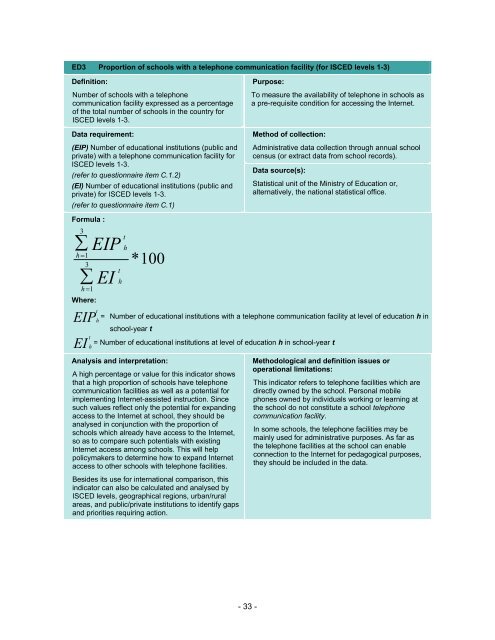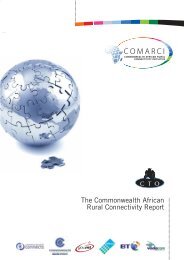Guide to measuring information and ... - unesdoc - Unesco
Guide to measuring information and ... - unesdoc - Unesco
Guide to measuring information and ... - unesdoc - Unesco
You also want an ePaper? Increase the reach of your titles
YUMPU automatically turns print PDFs into web optimized ePapers that Google loves.
ED3 Proportion of schools with a telephone communication facility (for ISCED levels 1-3)<br />
Definition:<br />
Number of schools with a telephone<br />
communication facility expressed as a percentage<br />
of the <strong>to</strong>tal number of schools in the country for<br />
ISCED levels 1-3.<br />
Data requirement:<br />
(EIP) Number of educational institutions (public <strong>and</strong><br />
private) with a telephone communication facility for<br />
ISCED levels 1-3.<br />
(refer <strong>to</strong> questionnaire item C.1.2)<br />
(EI) Number of educational institutions (public <strong>and</strong><br />
private) for ISCED levels 1-3.<br />
(refer <strong>to</strong> questionnaire item C.1)<br />
Formula :<br />
3<br />
<br />
h 1<br />
3<br />
<br />
h 1<br />
Where:<br />
EIP<br />
EI<br />
t<br />
h<br />
t<br />
h<br />
* 100<br />
- 33 -<br />
Purpose:<br />
To measure the availability of telephone in schools as<br />
a pre-requisite condition for accessing the Internet.<br />
Method of collection:<br />
Administrative data collection through annual school<br />
census (or extract data from school records).<br />
Data source(s):<br />
Statistical unit of the Ministry of Education or,<br />
alternatively, the national statistical office.<br />
EIP t<br />
= Number of educational institutions with a telephone communication facility at level of education h in<br />
h<br />
school-year t<br />
EI t<br />
= Number of educational institutions at level of education h in school-year t<br />
h<br />
Analysis <strong>and</strong> interpretation:<br />
A high percentage or value for this indica<strong>to</strong>r shows<br />
that a high proportion of schools have telephone<br />
communication facilities as well as a potential for<br />
implementing Internet-assisted instruction. Since<br />
such values reflect only the potential for exp<strong>and</strong>ing<br />
access <strong>to</strong> the Internet at school, they should be<br />
analysed in conjunction with the proportion of<br />
schools which already have access <strong>to</strong> the Internet,<br />
so as <strong>to</strong> compare such potentials with existing<br />
Internet access among schools. This will help<br />
policymakers <strong>to</strong> determine how <strong>to</strong> exp<strong>and</strong> Internet<br />
access <strong>to</strong> other schools with telephone facilities.<br />
Besides its use for international comparison, this<br />
indica<strong>to</strong>r can also be calculated <strong>and</strong> analysed by<br />
ISCED levels, geographical regions, urban/rural<br />
areas, <strong>and</strong> public/private institutions <strong>to</strong> identify gaps<br />
<strong>and</strong> priorities requiring action.<br />
Methodological <strong>and</strong> definition issues or<br />
operational limitations:<br />
This indica<strong>to</strong>r refers <strong>to</strong> telephone facilities which are<br />
directly owned by the school. Personal mobile<br />
phones owned by individuals working or learning at<br />
the school do not constitute a school telephone<br />
communication facility.<br />
In some schools, the telephone facilities may be<br />
mainly used for administrative purposes. As far as<br />
the telephone facilities at the school can enable<br />
connection <strong>to</strong> the Internet for pedagogical purposes,<br />
they should be included in the data.
















